#BKMTours
Photo
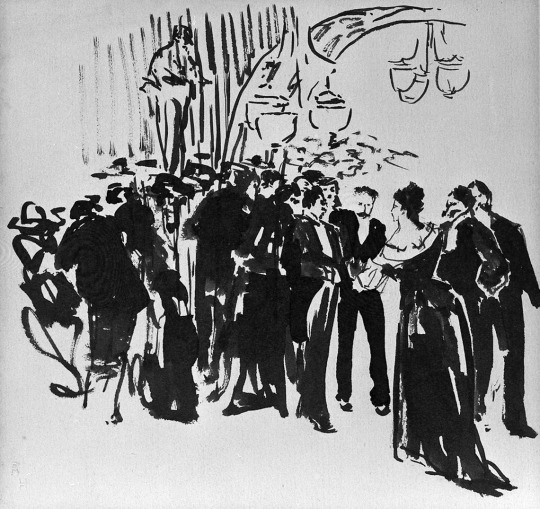
Squad goals. 👨👩👧👦
Don’t forget… you and your crew can level-up your Museum experience with a group tour. Whether you want to dive deeper into our permanent collection or have a knowledgeable guide to answer questions as you roam one of our special exhibitions—we have you covered.
Group tours accommodate up to twelve people and last about an hour and fifteen minutes. Get more information on pricing and availability: https://bit.ly/BkMTours
📷 Robert Henri (American, 1865-1929). Party Scene, ca. 1890-1900. Black ink on cream, moderately thick, smooth wove paper, Sheet (slightly irregular): 7 7/8 x 8 1/8 in. (20 x 20.6 cm). Brooklyn Museum, Gift of Dr. and Mrs. Theodore Leshner, 76.127.3 (Photo: Brooklyn Museum)
#Brooklyn Museum#brooklyn#museum#art#painting#exhibition#tour#BKMTours#New York City#nyc#things to do#nyc tour#tourism
36 notes
·
View notes
Photo

Hey! Hey! Hey! #Repost @brooklynmuseum ・・・ Hello, Atlanta! Our friends @spelmanmuseum are presenting Beverly Buchanan—Ruins and Rituals now through December 9. On the heels of our recent presentation, Spelman reunites #BeverlyBuchanan’s works to bring this important exhibition to the state the artist called home for much of her adult life. If you have a friend in Atlanta who you think will enjoy this show, tag them and tell them to check it out. #ruinsandrituals #bkmtours (at Spelman College Museum of Fine Art)
0 notes
Photo

#Repost @brooklynmuseum ・・・ Hello, Atlanta! Our friends @spelmanmuseum are presenting Beverly Buchanan—Ruins and Rituals now through December 9. On the heels of our recent presentation, Spelman reunites #BeverlyBuchanan’s works to bring this important exhibition to the state the artist called home for much of her adult life. If you have a friend in Atlanta who you think will enjoy this show, tag them and tell them to check it out. #ruinsandrituals #bkmtours
0 notes
Photo

👋, Munich! JR: Chronicles is now on view at Kunsthalle München from August 26, 2022-January 15, 2023.
JR: Chronicles immerses viewers in large-scale photographs, videos, and installations that document the community-based projects the artist has done around the world. The exhibition showcases the artist’s collaborative nature, unique storytelling, and commitment to civic discourse and social justice. If you have a friend in Munich who you think will enjoy this show, tell them to check it out!
📷 JR (French, born 1983). 28 Millimètres, Portrait d'une génération, B11, Destruction #2, Montfermeil, France, 2013. Installation image. Wheat-pasted posters on building. © JR-ART.NET
#Brooklyn Museum#brooklyn#museum#art#BkMTours#jr chronicles#exhibition#munich#photography#video#installation#art museum
58 notes
·
View notes
Video
The last ASL Tour of the season will explore community, healing, and remembrance through the work shown in “Guadalupe Maravilla: Tierra Blanca Joven” and “Rafael Lozano-Hemmer: A Crack in the Hourglass, An Ongoing COVID-19 Memorial.”
Members of the deaf community are invited to join us on May 21 at 2 pm for this free, in-person tour led by Joyce.
Save your spot: https://bit.ly/3ccftZk
#Brooklyn Museum#brooklyn#museum#new york#nyc#tour#asl tours#ASL#BKMTours#things to do#Guadalupe Maravilla#Rafael Lozano-Hemmer
21 notes
·
View notes
Photo

One is a wanderer, two is company, and up to ten is a group tour at the Museum.
Whether you’re bringing your family from out of town, a crew of colleagues, or a few friends, there’s a tour for you! Led by a team of art historians and educators, our group tours are available for many of our exciting collections as well as our special exhibitions. Experience our galleries together and discuss art with a focus on NYC history, female artists, Ancient Egyptian art, identity and representation, and more.
Group tours accommodate up to ten people and last about an hour and fifteen minutes. Get more information on pricing and availability: https://bit.ly/3qscSSE
📷 Utagawa Hiroshige (Ando) (Japanese, 1797-1858). Cotton-Goods Lane, Odenma-cho, No. 7 in One Hundred Famous Views of Edo, 4th month of 1858. Woodblock print. Brooklyn Museum, Gift of Anna Ferris, 30.1478.7
#Brooklyn Museum#brooklyn#museum#art#bkmtours#tour#nyc#things to do#art exhibitions#nyc history#ancient egypt#identity#representation
33 notes
·
View notes
Photo

Jean-Michel Basquiat. Candy Darling. Jed Johnson. Even Andy Warhol traveled in groups.
Do something different with your friends, family, classmates, or coworkers by booking a group tour of #WarholRevelation. Each tour provides a closer look at (and open conversation about) the mysterious man who created some of the most iconic art of the 20th century.
Group tours are open to ten people or fewer and last about an hour. Find out more and book your tour: https://bit.ly/3IvOSEh
📷: Visitors at Andy Warhol: Revelation. Brooklyn Museum November 19, 2021–June 19, 2022. (Photo: Jonathan Dorado, Brooklyn Museum. Artworks by Andy Warhol © 2021 The Andy Warhol Foundation for the Visual Arts, Inc. / Licensed by Artists Rights Society (ARS), New York. Used with permission of @warholfoundation) #warholfoundation
17 notes
·
View notes
Photo
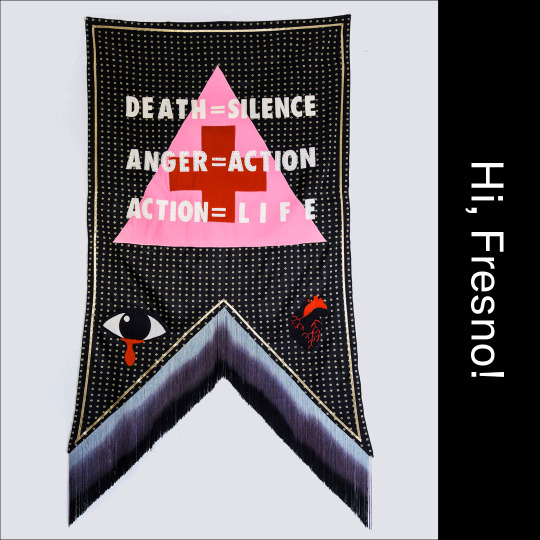
👋 Fresno! Our acclaimed exhibition Nobody Promised You Tomorrow: Art 50 Years After Stonewall is now on view at the Center for Creativity and the Arts at Fresno State until October 31.
Featuring all of the artists from our original presentation as well as new additions, the exhibition explores the profound legacy of the 1969 Stonewall Uprising within art and visual culture today. Nobody Promised You Tomorrow aims to contextualize the Stonewall Uprising beyond the protests, exploring the ways in which everyday acts and care sustain communities and public activism.
If you have a friend in Fresno who you think will enjoy this show, share this with them and tell them to check it out!
Posted by Olivia Gregory
Elektra KB (Colombian). Protest Sign II, 2017. Textile, felt, thread. Courtesy of the artist. © Elektra KB
#nobodypromisedyoutomorrow#Stonewall#Stonewall uprising#lgbtq+#prostests#uprising#community#activism#care#bkmtours
71 notes
·
View notes
Photo
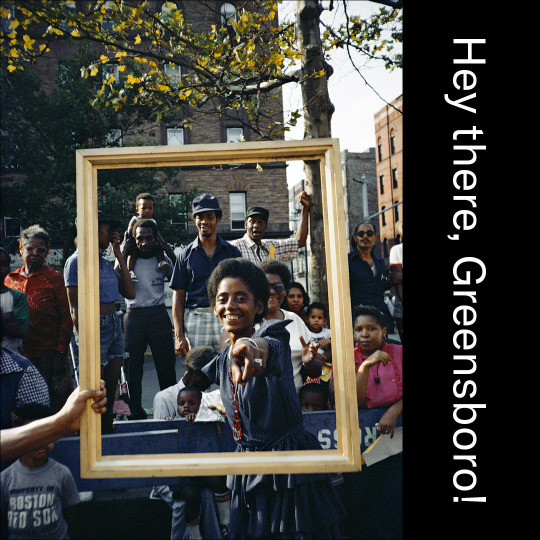
👋 Greensboro!
Lorraine O’Grady: Both/And is now open at Weatherspoon Art Museum and will be on view until April 30. Both/And is the first retrospective of one of the most significant contemporary figures working in performance, conceptual, and feminist art. With an artistic practice ranging across video, photomontage, concrete poetry, cultural criticism, and public art, Lorraine O’Grady’s work replaces either/or ways of thinking with the endless loop of “both/and,” challenging the fixed positions of self and other, here and there, and now and then.
If you have a friend in Greensboro who you think will enjoy this show, share this with them and tell them to check it out!
Lorraine O'Grady (American, born 1934). Art Is . . . (Girl Pointing), 1983/2009. Chromogenic photograph in 40 parts, 20 × 16 in. (50.8 × 40.64 cm). Edition of 8 plus 1 artist’s proof. Courtesy of Alexander Gray Associates, New York. © Lorraine O’Grady/Artists Rights Society (ARS), New York
11 notes
·
View notes
Photo

From iconic portraits of celebrities to appropriated Renaissance masterpieces, Andy Warhol played with styles and symbolism from Catholic art history, carefully reframing them within the context of Pop art and culture.
Our next Virtual ASL Tour will explore #WarholRevelation on February 26 from 2-3 pm. The virtual tour will begin after a brief meet-and-greet.
This is a free event, but space is limited. Reserve your spot: https://bit.ly/3ccftZk
📷: Conrado Johns
11 notes
·
View notes
Photo

👋 Dortmund! Studio 54: Night Magic opens today at Dortmunder U and will be on view until October 17, 2021.
Set in a former opera house with the stage innovatively repurposed as a dancefloor, Studio 54 allowed anybody to be a star. Presented in an immersive installation of photography, fashion, drawings, film, and material culture of the period, Studio 54: Night Magic traces the history of the most iconic nightclub of all time. If you have a friend in Dortmund who you think will enjoy this show, tag them and tell them to check it out!
Posted by Olivia Gregory
Miestorm Serpent (American, born 1958). R. Couri Hay and Alvin Ailey dancer, December 13, 1979. Courtesy of the artist. © Miestorm Serpent
#studio54bkm#bkmtours#studio 54#germany#dortmund#touring exhibitions#brooklyn museum#nyc#history#art#fashion#design#photography#drawings#film#material culture#new york city#Miestorm Serpent
37 notes
·
View notes
Photo
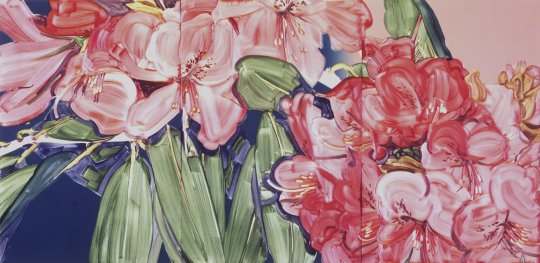
Springtime in Brooklyn
by Nancy Rosoff, Andrew W. Mellon Senior Curator, Arts of the Americas
As I look out my window at the falling rain, I know that these April showers will soon be followed by May’s flowers. The vibrant colors of budding trees and blossoming flowers give us hope that we will overcome the current crisis, and the world will be rejuvenated, stronger, and more unified. The following works from the Brooklyn Museum’s diverse collection celebrate the arrival of Spring and our hope for a healthy and more peaceful world.
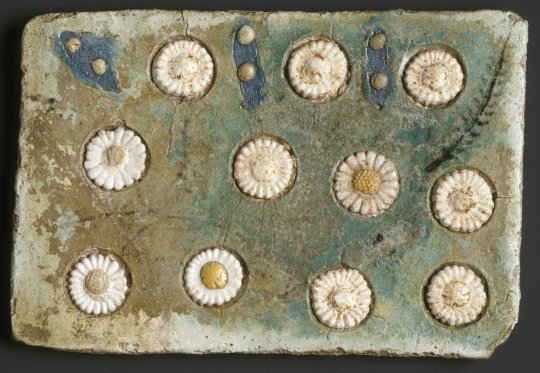
Brightly colored plants and flowers made of faience once decorated the walls of the Great Palace of king Akhenaten at Amarna. Sun light and the disk of the sun itself became the focus of religious worship in the Amarna period (1353-13336 B.C.E.). The floral motifs of these tiles were meant to evoke rebirth of life brought about by the sun. See the artwork in our open collection.

While the Nile was revered as a life-giving place, the desert was also teeming with nature. Here one can see animals breeding in their desert environs. To the right, a feline is showing interest in another feline. At the lower left, a male antelope, mounting his mate, rears his head into the row above. At the lower right, the hindquarters of an antelope giving birth and the emerging head of her calf are partly preserved. The bovine calf at center left completes this depiction of the cycle of life. See the artwork in our open collection.
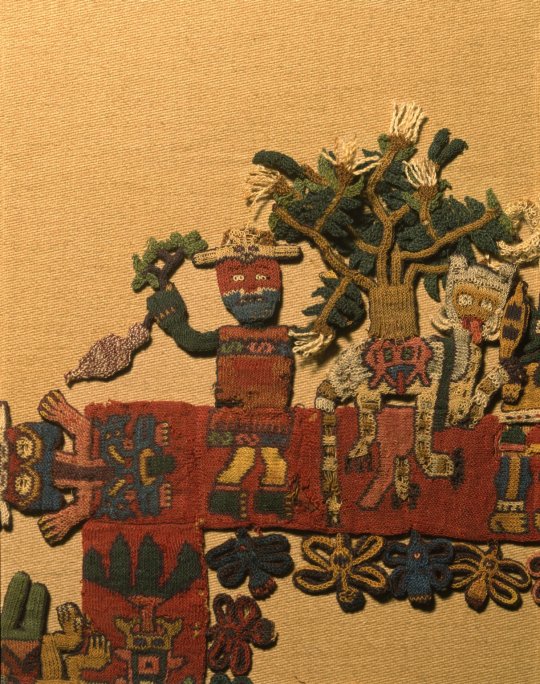
This detail from a Nasca mantle not only illustrates some of the plants and animals native to Peru’s South Coast, but it also conveys how the society’s spiritual beliefs are connected to agricultural seasons. The blossoming huarango tree seen here represents life and is shown growing out of a human trophy head on the back of a pampas cat. The trophy head symbolizes death but it is also a germinating seed from which life sprouts in a never-ending cycle of life, death, and rebirth. See the artwork in our open collection.

This late-seventeenth-century painting from viceregal Peru shows Saint Joseph standing hand-in-hand with the Christ Child in a field of blooming flora and enclosed within a border of bright carnations and lilies. Saint Joseph’s popularity flourished at this moment in the Spanish Americas as he embodied ideals of fatherhood, marriage, divinity, and masculinity. Here, he holds a stem of white lilies, which symbolize his holiness and purity. See the artwork in our open collection.
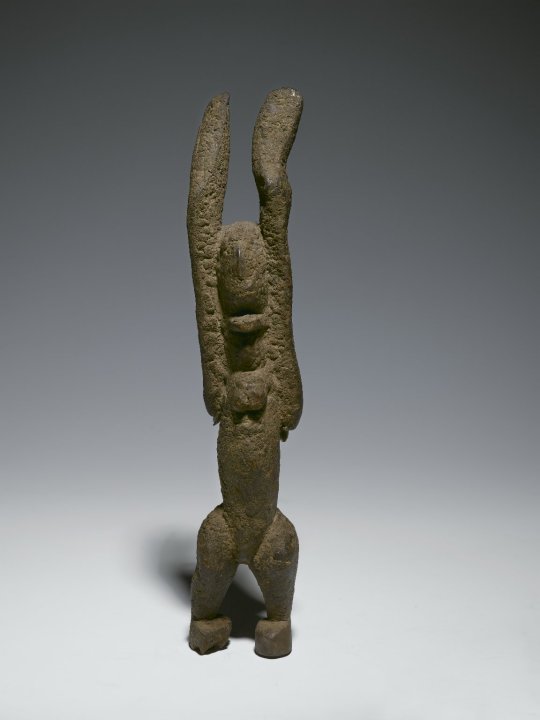
This sculpture would have served as a means for people to contact spiritual intermediaries for aid. Its raised arms are said to refer to prayers for rain, crucial to survive and thrive in arid the Mopti Region of Mali. See the artwork in our open collection.
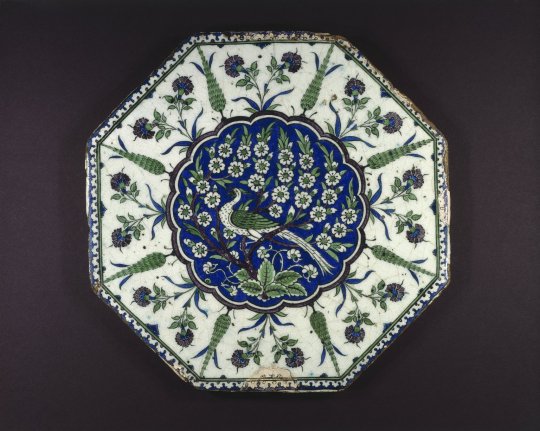
The use of naturalistic floral motifs, such as carnations, tulips, and hyacinths, was a trademark of the design workshop of the Ottoman court in Istanbul in the mid-sixteenth century. This design principle was adopted in central and distant areas of the empire and applied to different media, such as manuscript illuminations made in Istanbul, textiles made in Bursa, and tiles made in Iznik and Damascus. This octagonal tile from Syria brings the beauty of spring indoors permanently. See the artwork in our open collection.

Vibrant greens and blues bring a spring woodland scene inside the Museum, creating an eternal verdant landscape. The effects of changing sunlight or a passing cloud can animate the glass used to depict the stream, tree trunks and leaves. Originally installed in the Universalist Church of Our Father at Classon and Atlantic Avenues in Brooklyn, the windows were purchased by the All Souls Universalist Church on Ocean Avenue and installed in 1945, before coming to the Brooklyn Museum a few years ago. Tiffany Studio was extremely skilled at creating panoramas that open onto lush, brilliantly colored vistas. See the artwork in our open collection.
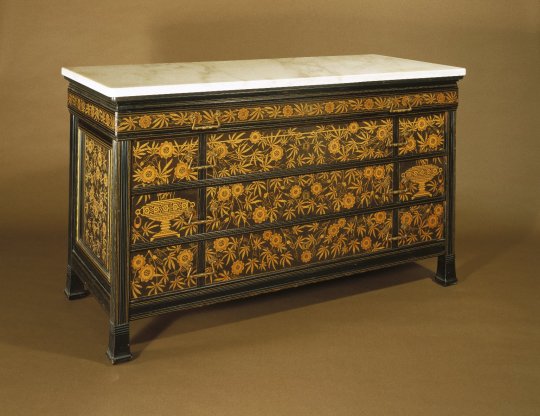
This elaborately decorated cabinet brought ever-blooming flowers into the owner’s bedroom. Inspired by Japanese precedents, New York’s most important late-19th-century furniture manufacturing firm Herter Brothers employed different colored woods to create the densely packed, abstracted flowers and leaves on this luxurious, yet functional chest-of-drawers. See the artwork in our open collection.
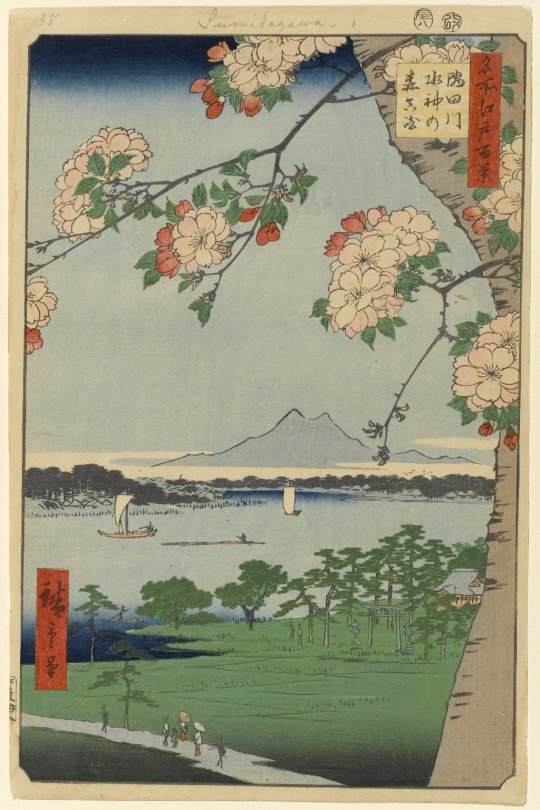
In the Japanese tradition, cherry blossom season is a time for celebration: the world wakes up after a long winter and people head outside to gather under the pink-and-white canopies created by trees that seemed barren only a week or two earlier. This year the picnics were cancelled, but in nature the show goes on whether there’s an audience or not. See the artwork in our open collection.
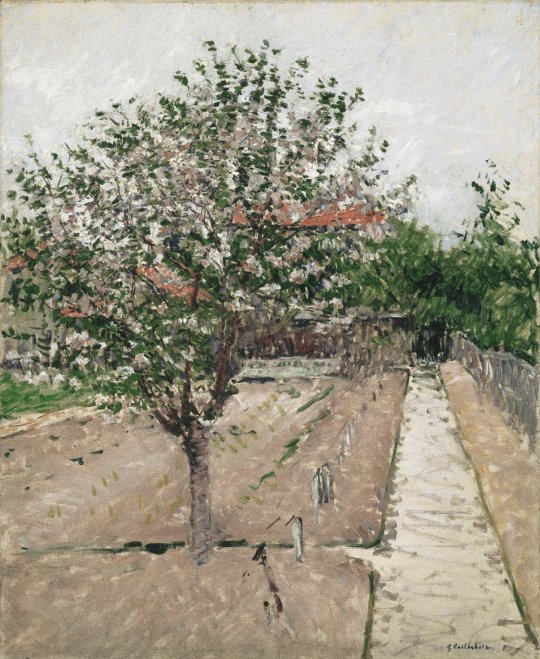
In this painting, Gustave Caillebotte offers a glimpse of his private garden in Petit Gennevilliers, a small village on the Seine opposite Argenteuil. The apple blossoms are rendered in thick touches of paint, which contrast with the sketchy treatment of the path that leads toward the denser foliage beyond the tree. See the artwork in our open collection.

Nothing celebrates Spring more than this dazzling child’s cap with its delicate beadwork on vibrant rose-colored velvet. It was lovingly made by the mother or female relative of a little girl who would have worn it with pride during special occasions. See the artwork in our open collection.
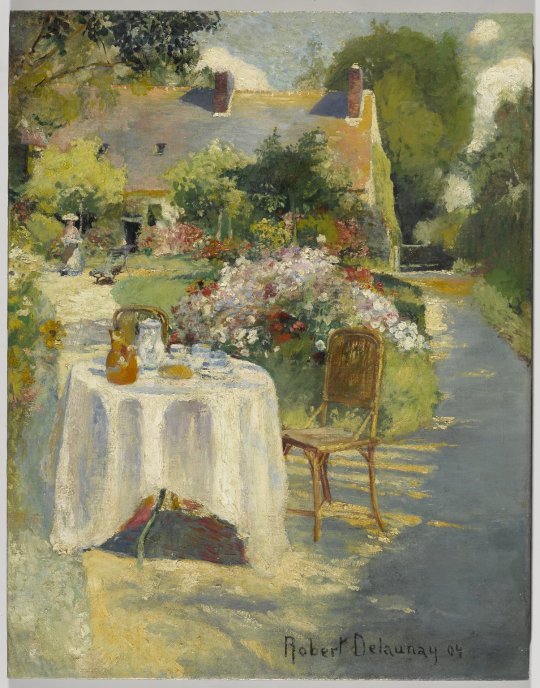
A table set with bread and coffee in a blooming garden along a sun-dappled path conjures the pleasures of the warmer months to come. Robert Delaunay would become known later in his career for more abstract work, but in this early painting the 19 year old artist was still working under the influence of Impressionism. See the artwork in our open collection.
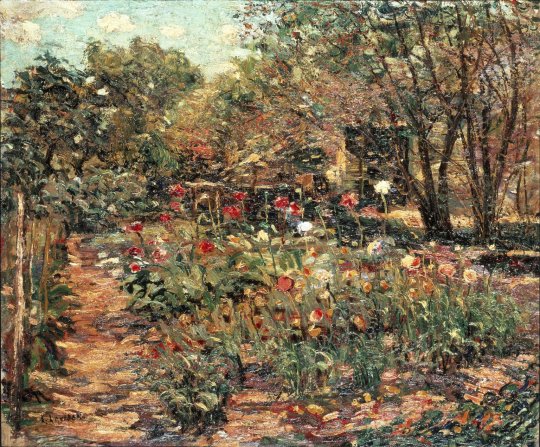
Redolent with the sweet scent of peonies, American Impressionist Ernest Lawson paints his flowerbeds in a dazzling display of jewel like tones in the Cos Cob art-colony located along the Connecticut shore. See the artwork in our open collection.
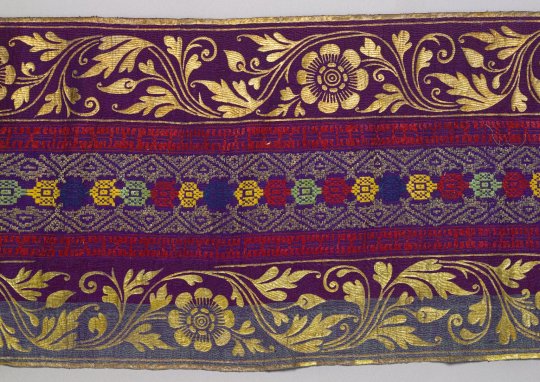
This Balinese cover features bright brocade rosettes in purple, blue, red, yellow, and green. The gilded gold overpaint features patra cina designs borrowed from Chinese floral patterns. Together, they create a glittering textile that is awash with color and floral motifs. See the artwork in our open collection.

One of the Brooklyn Museum’s most important Japanese paintings is a folding screen showing a group of urbanites walking together, followed by a musician and a servant with a big box. The only clue that they are heading to a cherry-blossom-viewing picnic comes from a woman who extends a branch of flowering cherry back toward a group of men. Attached to the branch is a long strip of paper of the type used traditionally in Japan for writing poems. What does the poem strip say? We don’t know, but it seems fair to guess that it serves as an invitation to romance. The screen reminds us that the spring tradition of partying beneath the cherry trees wasn’t solely about communing with nature. See the artwork in our open collection.
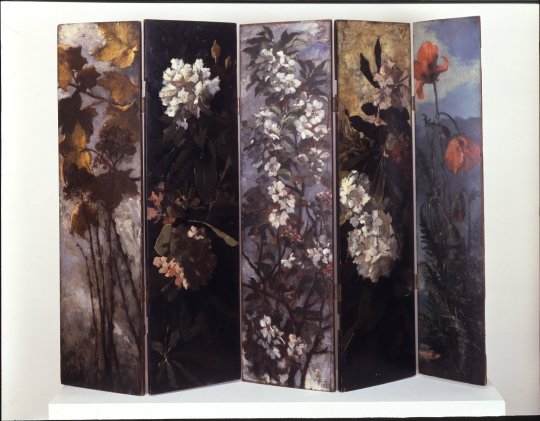
Inspired by Japanese folding screens or byōbu, Elizabeth Boott Duveneck’s five panels bring the natural world into the interior of the house depicting all four seasons from Autumn Foliage to Apple blossoms throughout the year. See the artwork in our open collection.

Beginning in the early 1930s, Consuelo Kanaga became one of few white photographers to make artistic portraits of Black Americans. This closely cropped and sharply focused image of a girl’s face with a flower was likely included in Group f.64’s inaugural exhibition in 1932, which announced a new realist direction in photography. Considered radical in its time, Frances with a Flower explores powerful ideas about beauty, gender, and race. See the artwork in our open collection.
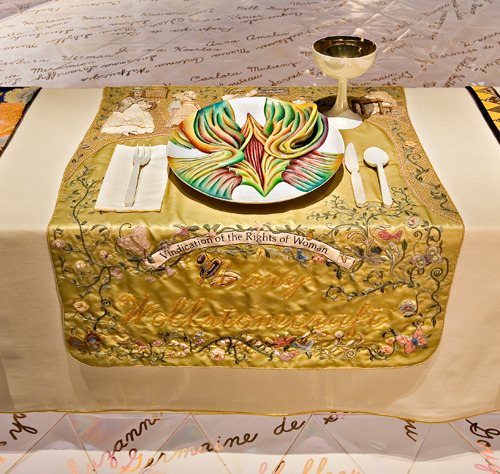
Mary Wollstonecraft was a renowned women’s rights activist who authored "A Vindication of the Rights of Woman," (1792), a classic of rationalist feminism that is considered the earliest and most important treatise, advocating for equality and education for women. Akin to the nature of Spring, Wollstonecraft's life symbolized the fruition of a legacy—from which infinite linages of women continue to reap the fruits of her labor. See the artwork in our open collection.

With rose-patterned leggings and an elaborate floral armature/headdress, Nick Cave’s Soundsuit transforms the human body into a lush garden. Since the early 1990s, Cave has been fabricating inventive sculptures out of scavenged materials, which he often overlays with beadwork, stitching, and other embellishments. One of the first, crafted from twigs, was made to be worn and created a rustling sound, which led to the eventual name of such works: Soundsuits. Cave’s costumes draw from a variety of sources, including both African and Caribbean traditions of masquerade. See the artwork in our open collection.
Posted by Nancy Rosoff with contributions from the Curators and Curatorial Assistants of African, American, Ancient Egyptian, Arts of the Americas, Asian, Contemporary, Elizabeth A. Sackler Center for Feminist Art, and Islamic Art
Photos: Gary Alan Bukovnik (American, born 1947). Rhododendrum, 1980. Lithograph on paper. Brooklyn Museum, Gift of the artist, 81.15.2. © Gary Alan Bukovnik(Photo: Brooklyn Museum); Tile with Floral Inlays, ca. 1352-1336 B.C.E. Faience. Brooklyn Museum, Gift of the Egypt Exploration Society, 35.2001. Creative Commons-BY (Photo: Brooklyn Museum); Relief with Desert Scene, ca. 2472-2455 B.C.E. Limestone, pigment. Brooklyn Museum, Charles Edwin Wilbour Fund, 64.147. Creative Commons-BY (Photo: Brooklyn Museum); Nazca. Mantle ("The Paracas Textile"), 100-300 C.E. Cotton, camelid fiber. Brooklyn Museum, John Thomas Underwood Memorial Fund, 38.12; Cuzco School. Saint Joseph and the Christ Child, late 17th-18th century. Oil on canvas. Brooklyn Museum, Museum Expedition 1941, Frank L. Babbott Fund, 41.1275.191 (Photo: Brooklyn Museum); Dogon. Nommo Figure with Raised Arms, 11th-15th century (possibly). Wood, organic sacrificial material. Brooklyn Museum, The Adolph and Esther D. Gottlieb Collection, 1989.51.39. Creative Commons-BY (Photo: Brooklyn Museum); Octagonal Tile Depicting Peacock in Prunus Tree, 16th century. Ceramic; fritware, painted in black, cobalt blue, green, and manganese purple under a transparent glaze. Brooklyn Museum, Gift of Jack A. Josephson, 1990.21. Creative Commons-BY (Photo: Brooklyn Museum); Tiffany Studios (1902-1932). Dawn in the Woods in Springtime, 1905. Stained glass window. Brooklyn Museum, Gift of All Souls Bethlehem Church, 2014.17.1. Creative Commons-BY; Herter Brothers (American, 1865-1905). Chest-of-Drawers, ca. 1880. Ebonized cherry, other woods, modern marble top, brass. Brooklyn Museum, Modernism Benefit Fund, 1989.69. Creative Commons-BY (Photo: Brooklyn Museum); Utagawa Hiroshige (Ando) (Japanese, 1797-1858). Suijin Shrine and Massaki on the Sumida River (Sumidagawa Suijin no Mori Massaki), No. 35 from One Hundred Famous Views of Edo, 8th month of 1856. Woodblock print. Brooklyn Museum, Gift of Anna Ferris, 30.1478.35 (Photo: Brooklyn Museum); Gustave Caillebotte (French, 1848-1894). Apple Tree in Bloom (Pommier en fleurs), ca. 1885. Oil on canvas. Brooklyn Museum, Bequest of William K. Jacobs, Jr., 1992.107.2 (Photo: Brooklyn Museum); Woodlands. Child's Cap, ca. 1890s. Velvet, cloth, beads. Brooklyn Museum, Gift of the Edward J. Guarino Collection in memory of Josephine M. Guarino, 2016.11.2. Creative Commons-BY; Robert Delaunay (French, 1885-1941). In the Garden (Dans le jardin), 1904. Oil on canvas. Brooklyn Museum, Gift of Iris and B. Gerald Cantor, 86.28 (Photo: Brooklyn Museum); Ernest Lawson (American, 1873-1939). Garden Landscape, ca. 1915. Oil on canvas. Brooklyn Museum, Bequest of Laura L. Barnes, 67.24.10 (Photo: Brooklyn Museum); Cover, 19th or early 20th century. Silk, pigment. Brooklyn Museum, Dick S. Ramsay Fund, 45.183.110. Creative Commons-BY; Cherry Blossom Viewing Picnic, ca. 1624-1644. Ink, color and gold leaf on paper. Brooklyn Museum, Gift of Frederic B. Pratt, 39.87. Creative Commons-BY (Photo: Brooklyn Museum); Elizabeth Boott Duveneck (American, 1846-1888). Apple Blossoms, 1882. Oil on wood panel. Brooklyn Museum, Gift of Joan Harmen Brown, Mr. and Mrs. William Slocum Davenport, Mrs. Lewis Francis, Samuel E. Haslett, William H. Herriman, Joseph Jefferson IV, Clifford L. Middleton, the New York City Police Department, Mrs. Charles D. Ruwe, Charles A. Schieren, the University Club, Mrs. Henry Wolf, Austin M. Wolf, and Hamilton A. Wolf, by exchange, Frank Sherman Benson Fund, Museum Collection Fund, Dick S. Ramsay Fund, Carll H. de Silver Fund, John B. Woodward Memorial Fund, and Designated Purchase Fund , 2005.54.3 (Photo: Brooklyn Museum); Consuelo Kanaga (American, 1894-1978). Frances with a Flower, early 1930s. Gelatin silver photograph. Brooklyn Museum, Gift of Wallace B. Putnam from the Estate of Consuelo Kanaga, 82.65.10 (Photo: Brooklyn Museum); Judy Chicago (American, b. 1939). The Dinner Party (Mary Wollstonecraft place setting), 1974–79. Mixed media: ceramic, porcelain, textile. Brooklyn Museum, Gift of the Elizabeth A. Sackler Foundation, 2002.10. © Judy Chicago. Photograph by Jook Leung Photography; Nick Cave (American, born 1959). Soundsuit, 2008. Mixed media. Brooklyn Museum, Mary Smith Dorward Fund, 2009.44a-b. © Nick Cave (Photo: Image courtesy of Robilant Voena)
#virtualtour#springtime#spring#brooklyn museum#museums#brooklyn#virtual tour#art#art museum#bkmtours#virtual tours
568 notes
·
View notes
Photo

👋 London! JR: Chronicles is now on view at Saatchi Gallery from June 4 - October 3, 2021. Featuring iconic works that highlight the voices of everyday people, JR: Chronicles demonstrates the artist’s ongoing commitment to community, collaboration, and civic discourse. Working at the intersections of photography, social engagement, and street art, the multimedia exhibition showcases original photographs, contact sheets, videos, and documentation of his public installations.
If you have a friend in London who you think will enjoy this show, share this with them and tell them to check it out!
Posted by Olivia Gregory
JR (French, born 1983). 28 Millimeters, Women Are Heroes, Action dans la Favela Morro da Providência, Stairs, a Few Days Later, Rio de Janeiro, Brazil, 2008. Color lithograph. © JR-ART.NET
#jr#bkmtours#jrbkm#jr chronicles#london#art#saatchi gallery#community#collaboration#civic discourse#photography#social engagement#street art#photographs#contact sheets#video#documentation#public installations
10 notes
·
View notes
Photo
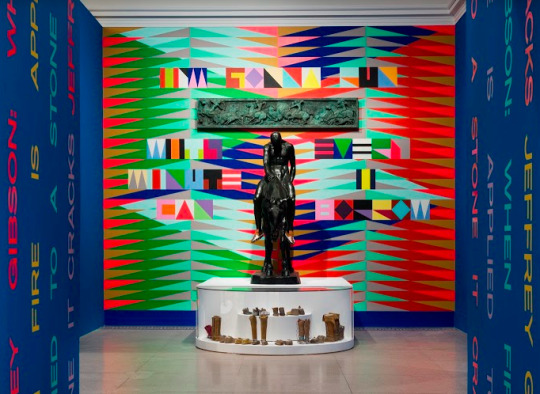
Join us for a virtual tour of “When Fire is Applied to a Stone it Cracks,” an exhibition organized by artist Jeffrey Gibson which makes the case that Native American art, including his own, has always been modern, innovative and global – a living culture reflected in vibrant communities across the continent.
Created by Eugenie Tsai, John and Barbara Vogelstein Senior Curator, Contemporary Art, and Erika Umali, Assistant Curator, Collections.

For centuries, museums have collected art and recounted the stories of communities and cultures without their direct input. In a break with this practice, the Brooklyn Museum invited Gibson to tell his own story as an artist of Native American descent, through his work and investigation of the museum’s holdings.
In keeping with his multidisciplinary practice, Gibson selected works from the museum’s holdings of Native American Art, American art, and photography, as well as from the Brooklyn Museum Library Special Collections and Archives.
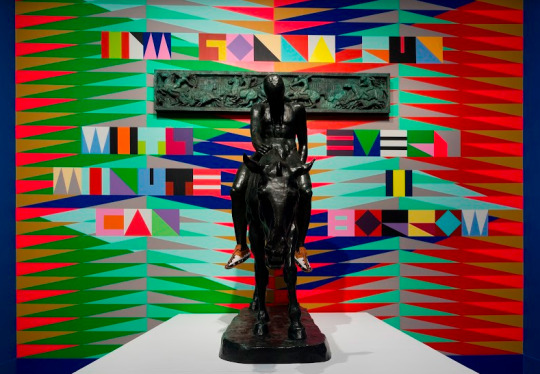
In the entrance gallery, set against a vibrant wall mural of his own design, Gibson highlights Charles Cary Rumsey’s bronze sculpture “ Dying Indian,” (circa1904) alongside other representations of Native Americans by non-Native artists.
The sculpture embodies a widely held view by Anglo-Americans in the early twentieth century that Native Americans were doomed to extinction as they were pushed ever west by settlers.

Gibson counters this view, asserting the continued vitality of Native American culture by adding a pair of commissioned beaded moccasins to the sculpture. Made by John Murie, they’re decorated with the phrase “I’m gonna run with every minute I can borrow,” which is also spelled out in the colorful wall mural behind the sculpture.
Taken from a song by Roberta Flack, the lyrics show how Gibson often includes language and references to pop culture into his work.

An arrangement of moccasins from the museum’s collection faces the sculpture, allowing us to imagine the absent bodies of the men, women, and children who once wore them.

In the adjacent gallery, also with wall murals designed by the artist, Gibson’s paintings on hide and on canvas with beadwork frames, sculptures, garments, and headpieces mingle with parfleche bags, beaded whimsies, and patchwork dresses by other Native artists.
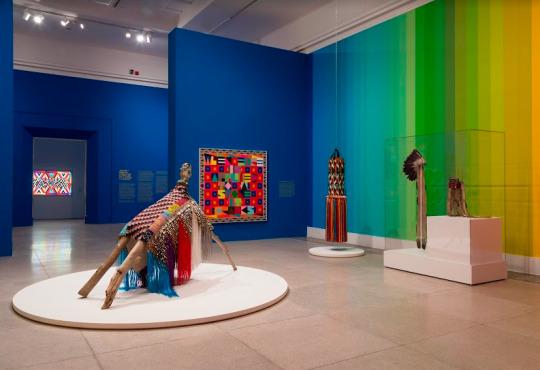
Gibson often employs materials and techniques that have historically been used by Native American makers, including beadwork, jingles, and ribbons, which he sometimes combines with contemporary forms such as punching bags. One of his beaded punching bag sculptures hangs from the ceiling.

Geometric letters spell out “WHEN FIRE IS APPLIED TO A STONE IT CRACKS,” an Irish proverb Gibson chose as the title of the exhibition. The image of fire applied to stone suggests transformation, whether this pertains to Indigenous makers using new materials and techniques or institutions rethinking the power dynamic in writing of historical narratives.
This painting refers to many artistic traditions, including European oil painting on canvas, text-based conceptual art, psychedelia, and Native American beadwork.
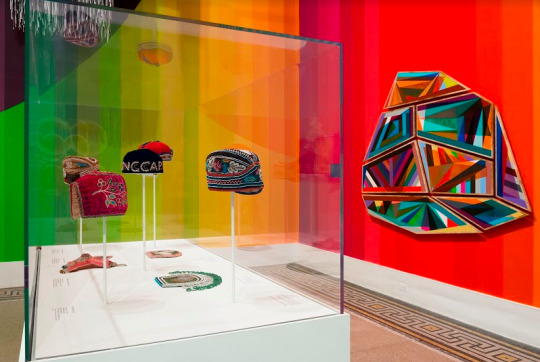
Gibson also paints on rawhide, a material used by Native Americans to make bags decorated with painted designs. This abstract work is composed of panels that fit together like a puzzle. Nearby are examples of beaded hats and bags from the collection. Many of these were made for the tourist market.

Nearby is a selection of painted parfleche bags drawn from the collection. Not so dissimilar from Gibson’s painted hide drums seen in the distance.

The third gallery largely focuses on photographs and material from the Museum’s Library Special Collections and Archives. Gibson worked with curatorial advisor Dr. Christian Crouch to select photos, paintings, and drawings from the papers of Stuart Culin, the curator who formed the collection of Native American Art at the Brooklyn Museum in the early 1900s.
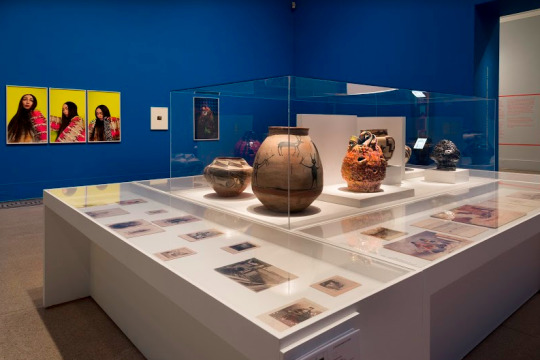
Gibson and Crouch decided to highlight images of Native men, women, and children, showing spontaneous representations of daily life as a form of resistance to the colonial gaze. Although they acknowledge Culin’s role in the foundations of the collection, the material on view centers Indigeneity, rejecting the exclusion and erasure of Indigenous histories that Museums have historically promoted.
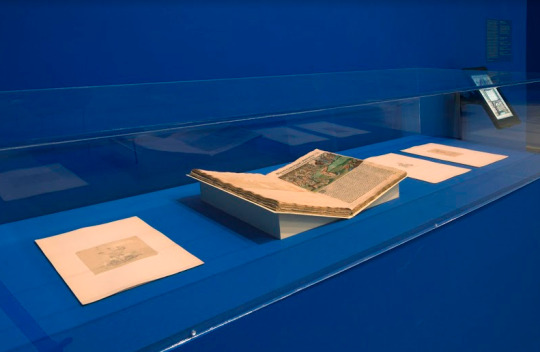
Many of the European explorers who journeyed to what we today call North America, recorded their travels and published them upon their return to Europe. Many of the European explorers who journeyed to Engravers like Theodor de Bry were hired to illustrate these manuscripts based on second hand accounts.
Since he could only imagine what they had seen, de Bry’s depictions were skewed to fit the Western world, creating some of the first inaccurate depictions of Indigenous Peoples--the reverberations of which are still felt today.
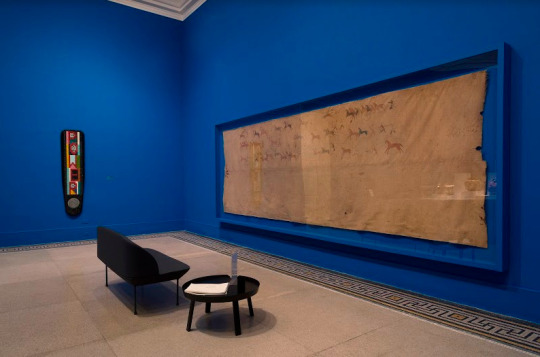
This tipi liner by Húŋkpapȟa Lakota leader Rain-In-The-Face is a visual representation of his life’s deeds. Made by his own hand, it is a first person account as well as a self portrait and a self representation in contrast to the photographic portraits of Native American people from the same period in this gallery.
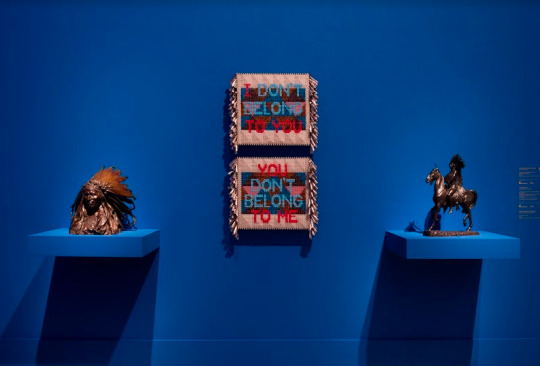
Visually striking and intellectually provocative,”When Fire Is Applied to a Stone It Cracks” is an original and innovative project: inviting a more expansive narrative that includes and integrates the histories of Indigenous people and challenging visitors to reconsider their assumptions of what Native American art can be.
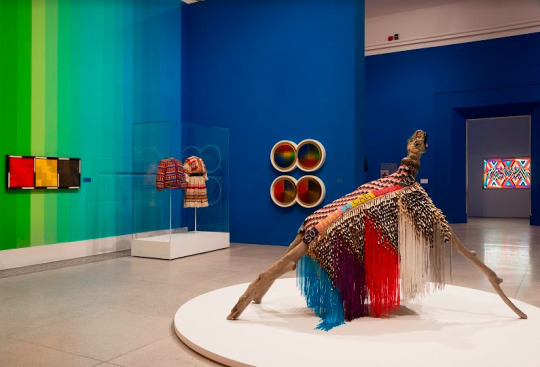
Shout out to Nancy Rosoff, Andrew W. Mellon Senior Curator, Molly Seegers, Museum Archivist, Margarita Karasoulis, Assistant Curator of American Art, and Drew Sawyer, Phillip Leonian and Edith Rosenbaum Leonian Curator of Photography for their incredible work on this exhibition as well.
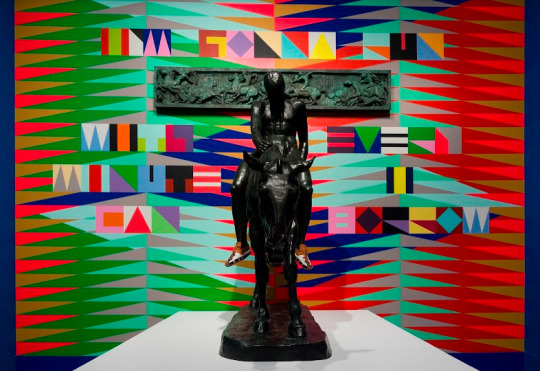
Thank you for joining us on our tour of Jeffrey Gibson: When Fire Is Applied to a Stone It Cracks Join next Sunday for another virtual tour of our galleries!
Installation view of Jeffrey Gibson: When Fire Is Applied to a Stone It Cracks, February 14, 2020–January 10, 2021. (Photo: Jonathon Dorado)
(Source: brooklynmuseum.org)
#virtualtour#virtual tours#virtual programming#brooklyn#brooklyn museum#art#artmuseum#bkmtours#jeffrey gibson#gibson#native american
310 notes
·
View notes
Photo

Join us as we take a closer look at Giovanni della Robbia’s Resurrection of Christ (ca. 1520–25). Tag along for this virtual tour created by Lisa Small, Senior Curator, European Art.
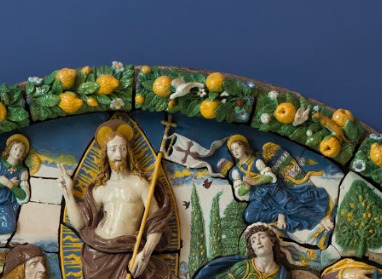
The sculpture envisions Jesus emerging from his tomb offering salvation to the faithful. Heralded by two angels, in one hand he holds the red-cross banner representing his triumph over death and with the other makes a gesture of benediction. A lush garland of plants, flowers, and animals frames the miraculous event.

This large relief sculpture is made up of forty-six separate pieces of molded terracotta. After being fired in a kiln, each section was painted with the della Robbia workshop’s proprietary glazes, and then fired again, a technique that yielded a colorful and durable form of sculpture perfectly suited to architectural ornamentation.
The lunette, or arched shape, suggests that this work would have hung over a doorway.
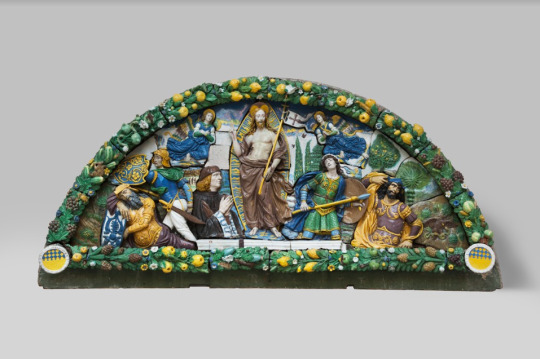
Like many Renaissance artists, della Robbia was inspired by ancient Greek and Roman art. In this work, he unites classical forms with Christian symbols.
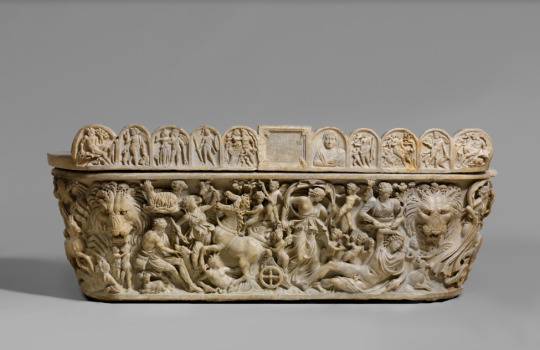
The arrangement of figures within the compressed space of the relief shows della Robbia’s familiarity with the crowded compositions carved on ancient Roman sarcophagi like this one from the Met.
Marble sarcophagus with the myth of Selene and Endymion, Roman, early 3rd century A.D.. Marble, H. 28 1/2 in. Metropolitan Museum, Rogers Fund, 1947. 47.100.4a, b.
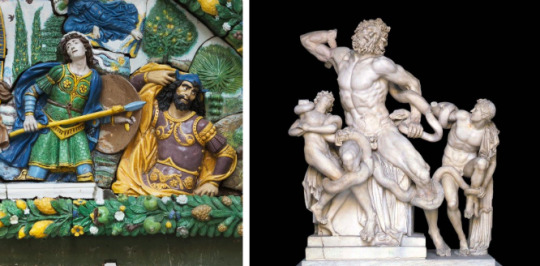
The twisted poses and emotional faces of these two soldiers echo those of the Laocoön group, an ancient sculpture unearthed in Rome in 1506 that soon became one of the most famous ancient works known in the Renaissance.
Laocoön and his sons. Roman copy in marble after a Hellenistic bronze original from ca. 200 BC., 1506, The Vatican Museums, Rome.
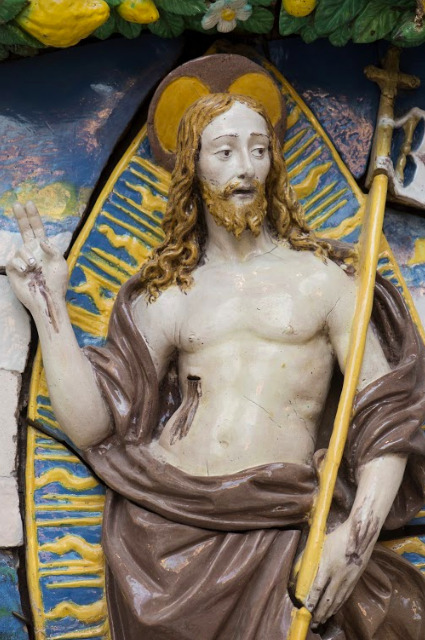
Here, Christ stands in the relaxed contrapposto pose frequently seen in classical sculptures of the male nude.
Della Robbia’s workshop couldn’t develop a stable glaze for red, which was the intended color of Christ’s robe and His blood. Those sections had to be covered in red paint, which has since worn off, leaving those areas looking brown.
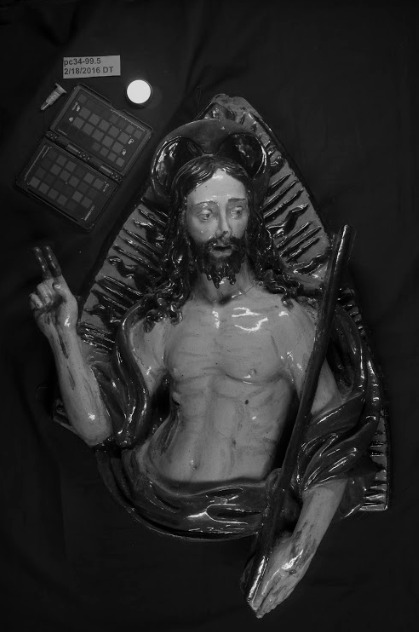
Ultraviolet reflectance imaging reveals that della Robbia painted glaze onto Christ’s arms, chest, and abdomen to emphasize his muscles!
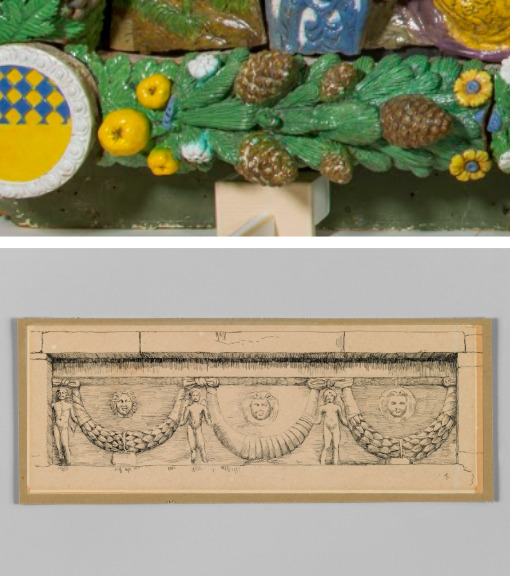
The hallmark leafy garland of the della Robbia workshop was also a common motif in the ancient world. It signified honor and commemoration, as well as glory and abundance.
Artist James Tissot depicted a typical ancient garland design in this sketch from the Brooklyn Museum collection of a Roman sculptural fragment he saw in 1886-1889 while traveling near Jerusalem.
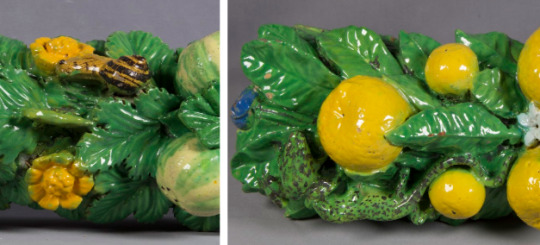
The flora and fauna throughout the relief reflect the interest in the natural world that emerged during the Renaissance. These plants and animals would have been understood at the time as having symbolic meanings connected with the themes of Resurrection and faith.
Evergreen leaves, gourds, salamanders, and snails were all emblematic of rebirth, renewal, and immortality.

Frogs could also serve as symbols of the Resurrection because they appear to be “reborn” seasonally when they emerge after hibernation in the spring. The crab is the zodiac sign for Cancer, but can also be a Resurrection symbol because it sheds its shell as it grows.

This vignette of an eagle killing a snake references Christ’s triumph over Satan.
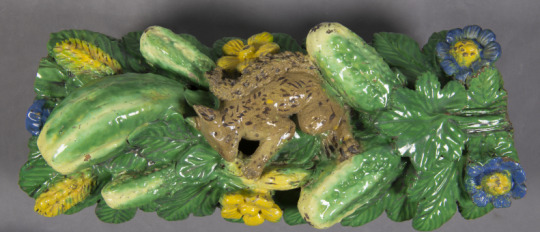
Such animal symbolism was complex and often contradictory. Although squirrels were sometimes associated with evil, they could also be positive symbols of diligence.

Della Robbia or someone in his workshop must have been particularly interested in this small creature; conservation analysis has revealed what appears to be a small preparatory sketch of a squirrel scratched into the wet clay on one of the garland tiles.

A blooming fruit tree represents Paradise and the regeneration of the world through Christ’s sacrifice.
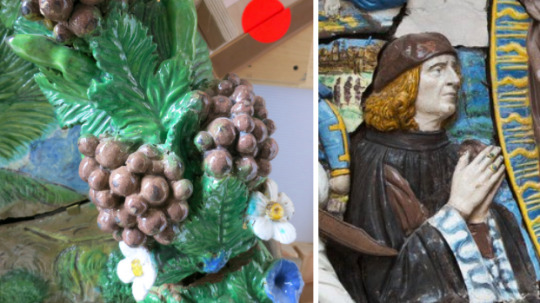
Grapes conjure abundance as well as the wine the disciples drank at Christ’s Passover seder (otherwise known as the Last Supper!).
In this work grapes probably also allude to this praying man. Who is he and how did he get a front row seat to the Resurrection?
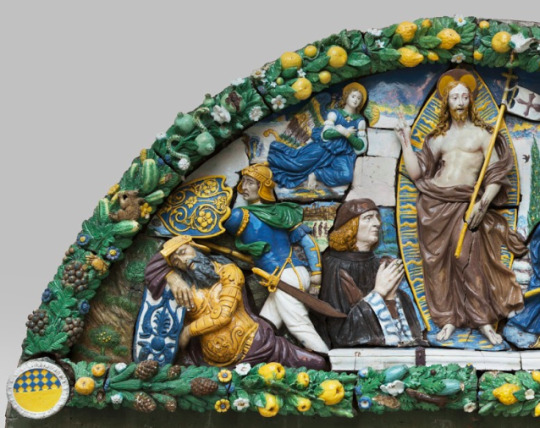
He is likely Niccolò di Tomasso Antinori (1454–1520), whose family coat of arms appears in the lower corners of the relief. The Antinoris were wealthy merchants and winemakers, and they commissioned della Robbia to create this work for their estate and vineyard outside Florence.
As the patron, Niccolò could emphasize his own salvation by specifying that he be included in a position of devotion right next to the Risen Christ.
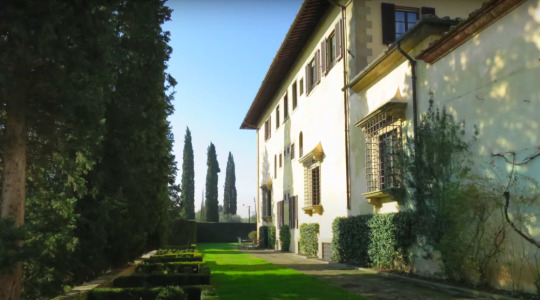
Della Robbia’s Resurrection remained at the Antinori estate until 1898, when the family sold it to A. Augustus Healy, the Brooklyn Museum’s first board president.

When he gave it to the museum the next year, The Brooklyn Daily Eagle proclaimed: “Every lover of Italian art will value . . . this treasure.”
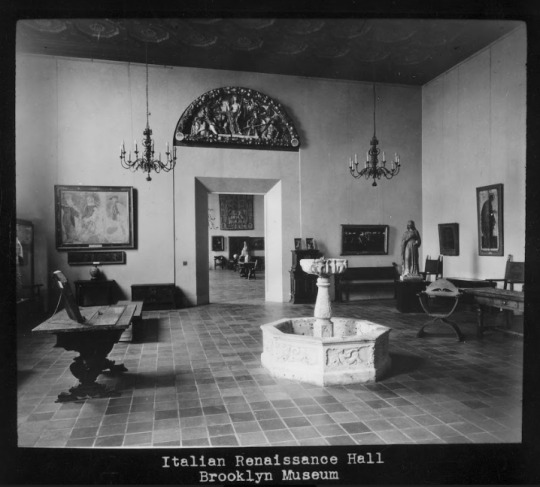
It hung for years in the museum’s “Renaissance Hall” but by later in the twentieth century it had gone into storage.
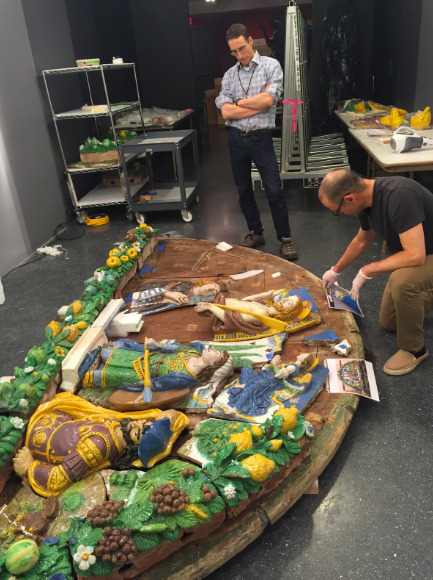
In 2015 it was completely conserved at the Brooklyn Museum thanks to a grant from the same Antinori family that originally commissioned it 500 years ago! Now, della Robbia’s early sixteenth-century masterpiece looks better than ever!
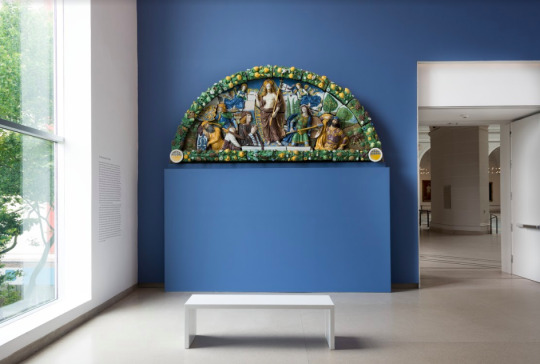
Thanks for joining us! Tune in next Sunday for another virtual tour of our galleries!
Installation view of The Brooklyn Della Robbia. (Photo: Jonathan Dorado)
(Source: brooklynmuseum.org)
#virtual tours#brooklynmuseum#brooklyn#art#artmuseum#Dellarobbia#Virtual tour#bkmtours#tours#della robbia#brooklyn museum#renaissance art#italian renaissance#european art#virtualtour
251 notes
·
View notes
Photo

Join us for tours of the Brooklyn Museum in Spanish on select Saturday afternoons this spring! Through a partnership with Brooklyn College, two Spanish translation students will hone their language skills by leading highlights tours and providing bilingual translations thematic tours led by ART Guides. Check out the schedule below and we hope to see you there!
Únase a nosotros para recorridos en español por el Museo de Brooklyn en algunos sábados por la tarde esta primavera. Atraves de una asociación con Brooklyn College, dos estudiantes de traducción al español perfeccionarán sus habilidades lingüísticas ofreciendo visitas temáticas con traducciones bilingües dirigidas por maestros ART. Miren al calendario y esperamos verles allí.
Obras Mas Destacadas—Sábados, 7 de Marzo, 4 de Abril y 2 de Mayo, 1-2 pm
Acompáñanos en un recorrido gratuito de las obras más destacadas del museo en español, dirigida por un estudiante de Brooklyn College.
Gallery Tour: Collection/Visita Guiada de la Colección — Saturdays, March 7, April 4, and May 2, 2-3 pm (Sábados, 7 de Marzo, 4 de Abril y 2 de Mayo, 2-3 pm)
Join a Museum Guide for a free tour exploring our collection in depth. This tour is offered bilingually in English and Spanish, with translations provided by students from Brooklyn College. To find out which collection areas this tour will visit, check at the Admissions Desk when you arrive.
Acompaña un guía del museo para un recorrido gratuito y bilingüe explorando nuestra colección en forma más profunda. Esta visita guiada se brinda bilingüe en inglés y español, con traducciones ofrecidas por estudiantes de Brooklyn College. Para saber qué áreas de la colección visitarán, consulta el mostrador de admisiones cuando llegues.
Posted by Christina Marinelli
Photo: Students from Brooklyn College, leading tours of the Museum in Spanish. (Photo: Christina Marinelli)
#bkmeducation#brooklyn museum#brooklyn college#education#art#spanish#bilingual#free#museum visitors#art history#bkmtours#art museum
38 notes
·
View notes